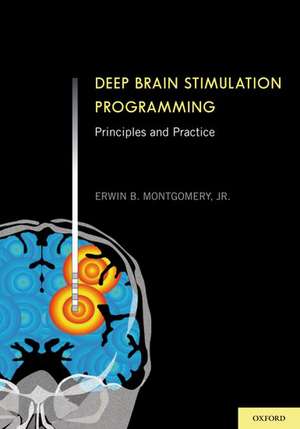Deep Brain Stimulation Programming: Principles and Practice
Autor MD, Erwin B. Montgomery, Jr.en Limba Engleză Hardback – 14 apr 2010
Preț: 468.89 lei
Preț vechi: 501.95 lei
-7% Nou
Puncte Express: 703
Preț estimativ în valută:
89.73€ • 95.94$ • 74.81£
89.73€ • 95.94$ • 74.81£
Carte tipărită la comandă
Livrare economică 17-23 aprilie
Preluare comenzi: 021 569.72.76
Specificații
ISBN-13: 9780199738526
ISBN-10: 0199738521
Pagini: 179
Ilustrații: 71 illustrations
Dimensiuni: 178 x 254 x 18 mm
Greutate: 0.68 kg
Editura: Oxford University Press
Colecția OUP USA
Locul publicării:New York, United States
ISBN-10: 0199738521
Pagini: 179
Ilustrații: 71 illustrations
Dimensiuni: 178 x 254 x 18 mm
Greutate: 0.68 kg
Editura: Oxford University Press
Colecția OUP USA
Locul publicării:New York, United States
Descriere
Deep Brain Stimulation (DBS) is a remarkable therapy for an expanding range of neurological and psychiatric disorders. In many cases it is better than best medical therapy and succeeds even when brain transplants fail. Yet despite the remarkable benefits, many physicians and healthcare professionals seem hesitant to embrace this therapy. Post-operative programming of the DBS systems seems unfamiliar, even mysterious, and is viewed as difficult and time consuming. However, DBS programming is rational and can be efficient and effective if one understands the basing underlying concepts of electronics, electrophysiology, and the relevant regional anatomy. Even these principles can be relatively easy to grasp.The book helps the reader to obtain an intuitive understanding of the basic principles of electronics, electrophysiology and the relevant regional anatomy through the use of readily understood metaphors and numerous illustrations. In addition a number of tools are provided including algorithms to ensure efficient and thorough programming. Forms are provided to help with documentation. In addition, DBS related research provides a remarkable tool to understand how the brain works and what happens in diseases such as Parkinson's disease. Already long cherished theories of the pathophysiology of Parkinson's disease must be abandoned. Indeed, these DBS derived insights suggest fundamental revisions of theories of brain function are in order. The book provides an introduction to where some of the new theories may lead particularly with the growing awareness of the importance ofoscillations in the brain's activities. The brain has more in common with electrical devices, such as computers, than it does to a stew of chemicals. DBS operates at the electrical level in the brain, which is fundamental to how the brain creates, manipulates and conveys information and may indeedbe fundamental to the misinformation the results in the dysfunction related to disorders of the brain.
Notă biografică
Dr. Montgomery's research interests are in motor neurophysiology of the basal ganglia, pathophysiology of Parkinson's disease and in the therapeutic mechanisms of action of Deep Brain Stimulation. His works spans human and non-human primate research and computational modeling and simulations. He received his MD degree from the State University of New York at Buffalo and studied neurophysiology under Gary Allen Ph.D. in the Laboratories of Sir John Eccles. Dr.Montgomery's clinical practice is in Movement Disorders and Deep Brain Stimulation. He has been involved in Deep Brain Stimulation research and clinical practice since 1997.






